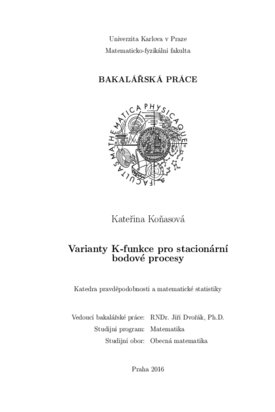Varianty K-funkce pro stacionární bodové procesy
Alternative K-functions for stationary point processes
bakalářská práce (OBHÁJENO)

Zobrazit/
Trvalý odkaz
http://hdl.handle.net/20.500.11956/79574Identifikátory
SIS: 167947
Katalog UK: 990020944260106986
Kolekce
- Kvalifikační práce [11978]
Autor
Vedoucí práce
Oponent práce
Prokešová, Michaela
Fakulta / součást
Matematicko-fyzikální fakulta
Obor
Obecná matematika
Katedra / ústav / klinika
Katedra pravděpodobnosti a matematické statistiky
Datum obhajoby
27. 6. 2016
Nakladatel
Univerzita Karlova, Matematicko-fyzikální fakultaJazyk
Čeština
Známka
Výborně
Klíčová slova (česky)
stacionární bodové procesy, K-funkce, směrová K-funkce, válcová K-funkceKlíčová slova (anglicky)
stationary point processes, K-function, directional K-function, orientation analysisHlavním tématem této práce je teorie stacionárních bodových procesů, s důra- zem na varianty K-funkce pro bodové procesy v rovině. V první kapitole vyložíme základy teorie bodových procesů včetně klasické definice K-funkce a jejího nepa- rametrického odhadu. Tato funkce představuje cenný nástroj pro posuzování re- gularity nebo naopak tendence k vytváření shluků u bodových procesů. Ve druhé kapitole podáme shrnutí poznatků o variantách K-funkce pro stacionární bodové procesy ve dvourozměrném resp. trojrozměrném eukleidovském prostoru. Naši pozornost zaměříme na válcovou K-funkci, využívající různě orientovaných válců resp. obdélníků, a směrovou K-funkci, která využívá kruhových resp. kulových výsečí. Ve třetí kapitole nabídneme porovnání směrové K-funkce a jejího nepa- rametrického odhadu pro anizotropní Thomasové procesy. Dále zde ilustrujeme hlavní přínos směrové K-funkce při analýze bodových procesů, spočívající ve vy- užití směrové K-funkce při detekci dominantního směru pro shluková i regulární data. 1
The main theme of this thesis is the theory of stationary point processes, in particular the directional K-function. In the first chapter we explain the essentials of planar point process theory including the classical definition of K-function and its estimator. The second chapter introduces two types of the directional K-function: cylindrical K-function whose structural element is a cylinder and directional K-function using double spherical cones. The third chapter presents the comparison of directional K-function and its estimator on an anisotropic version of Thomas process. We also illustrate the major contribution of directional K-function in orientation analysis of point patterns. We introduce a heuristic method for detecting anisotropies in clustered or regular data. 1
